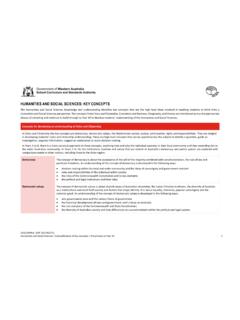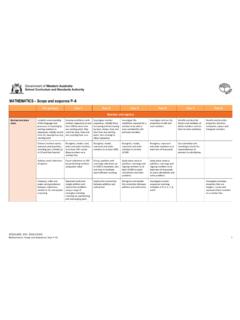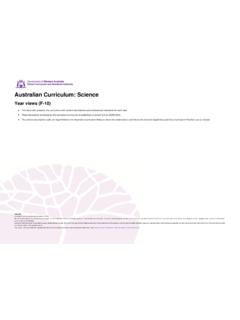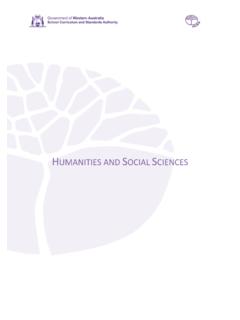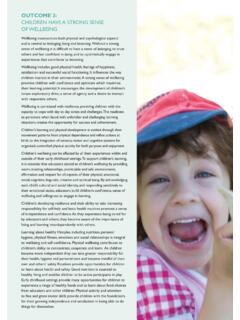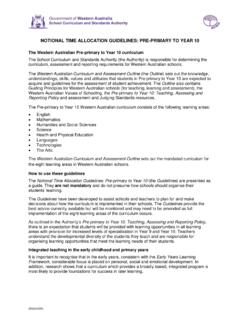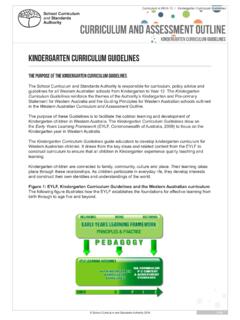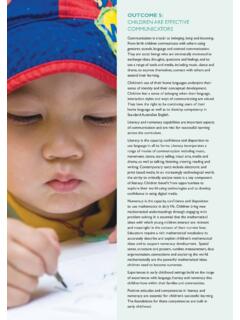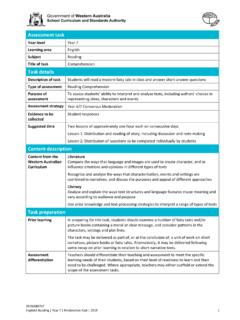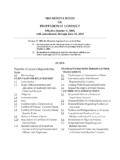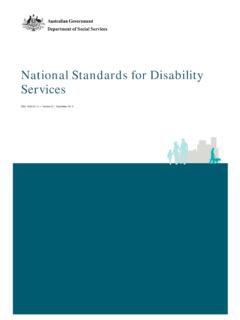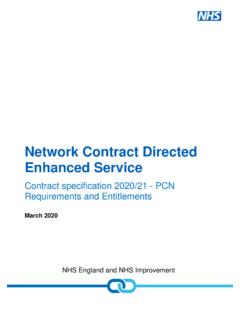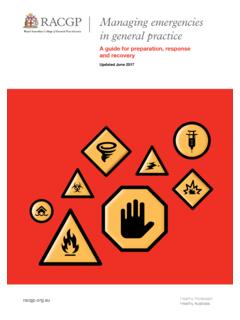Transcription of HEALTH AND PHYSICAL EDUCATION Scope and sequence …
1 HEALTH AND PHYSICAL EDUCATION Scope and sequence P 6. Pre-primary Year 1 Year 2 Year 3 Year 4 Year 5 Year 6. Attitudes and values Students identify attitudes and values for a healthy, active lifestyle and demonstrate values consistent with the prevention of ill- HEALTH ; the acceptance of personal responsibility for their HEALTH and PHYSICAL activity levels; respect for social justice principles; and a commitment to personal achievement. The HEALTH and PHYSICAL EDUCATION curriculum provides opportunities for students to develop, enhance and exhibit attitudes and values that promote a healthy lifestyle. Personal, social and community HEALTH Being healthy, safe and Personal strengths of Personal strengths and Personal strengths and Factors that strengthen Use of persistence and Ways that individuals Ways that personal active individuals how these change over achievements and how personal identities, such resilience as tools to and groups adapt to identities change over time they contribute to as the influence of: respond positively to different contexts and time The different parts of the personal identities family challenges and failure, situations body and where they are The strengths of others friends such as.
2 Strategies and resources located and how they contribute Changes in relationships school using self-talk Changes associated with to understand and to positive outcomes, and responsibilities as seeking help puberty which vary with manage the changes and Protective behaviours to such as games and individuals grow older PHYSICAL , social and thinking optimistically individuals: transitions associated keep safe and healthy: PHYSICAL activities emotional changes that PHYSICAL with puberty, such as: saying no' Strategies to use when occur as individuals grow Strategies that help mental minimising and moving away Ways in which the body help is needed: older, such as changes individuals to manage emotional managing conflict telling an adult changes as individuals procedure and practice to: the impact of PHYSICAL , recognising and asking for help grow older for dialling 000 in an the body social and emotional Reliable sources of building emergency friendships changes, such as: information that inform self-esteem Trusted people in the Strategies to use when locating safety houses feelings positive self-talk HEALTH , safety and selecting and community who can help help is needed, such as: and trusted networks assertiveness wellbeing, such as: managing individuals feel safe dialling 000 in an in the local community Assertive behaviours and seeking help internet-based relationships emergency communication skills to sharing information reading basic safety Strategies and behaviours respond to unsafe responsibilities community HEALTH Criteria that can be signs that promote HEALTH and situations, such as: organisations applied to sources of accessing a safety wellbeing.
3 Keeping calm Personal behaviours and publications and other information to assess house or a trusted personal hygiene using appropriate strategies to remain safe media their credibility network practices non-verbal in uncomfortable or asking a trusted adult healthy eating communication skills unsafe situations, such Strategies that promote Strategies that promote sufficient sleep seeking help as: a safe, healthy lifestyle, a healthy lifestyle, such The benefits of healthy staying hydrated being alert and aware such as: as: eating and regular regular PHYSICAL activity Actions in daily routines of unsafe situations comparing food labels refusing medicines, PHYSICAL activity on HEALTH that promote HEALTH , using assertive on products tobacco, alcohol or and wellbeing safety and wellbeing: behaviour and increased PHYSICAL other drugs healthy eating language activity improving the appropriate levels of practising sun safety nutritional value in PHYSICAL activity meals 2016/12049 [PDF 2016/13031].
4 HEALTH and PHYSICAL EDUCATION | Scope and sequence | Year P-10 1. HEALTH AND PHYSICAL EDUCATION Scope and sequence P 6. Pre-primary Year 1 Year 2 Year 3 Year 4 Year 5 Year 6. Being healthy, safe and knowing who or increasing PHYSICAL active where to go for help activity in the community being safe in an online environment Strategies to ensure safety and wellbeing at home and at school, such as: following school rules identifying and choosing healthier foods for themselves Communicating and Personal and social skills Appreciation and Strategies to include Behaviours that show The positive influence of Skills and strategies to Skills to establish and interacting for HEALTH to interact with others: encouragement of the others in activities and empathy and respect for respect, empathy and establish and manage manage positive and wellbeing expressing needs, behaviour of others games others the valuing of relationships over time, relationships, such as: wants and feelings through the use of: differences in such as.
5 Showing respect and active listening manners Ways to interpret the Circumstances that can relationships exploring why empathy self-discipline positive language feelings of others in influence the level of relationships change being cooperative praise different situations, such emotional response to Strategies to identify and assessing the impact actively listening Emotional responses as: situations manage emotions before of changing being trustworthy individuals may Positive ways to react to words other people reacting relationships on accepting differences experience in different their own emotions in use Choices and behaviours HEALTH and wellbeing situations, such as different situations, such facial expressions conveyed in HEALTH Strategies to cope with building new Situations in which feeling: as: body language information and adverse situations and friendships emotions can influence happy walking away messages the demands of others dealing with bullying decision-making: sad seeking help Ways HEALTH messages and harassment in peer group excited remaining calm are communicated in the Ways in which HEALTH with friends tired media and how they can information and Ways in which with family angry Ways HEALTH messages influence personal HEALTH messages can influence inappropriate emotional during sporting or scared are communicated on: choices, such as slip, HEALTH decisions and responses impact on PHYSICAL activities television slop, slap' behaviours relationships, such as: confused posters loss of trust Appropriate language and radio fear actions to communicate loss of respect feelings in different situations HEALTH and PHYSICAL EDUCATION | Scope and sequence | Year P-10 2.
6 HEALTH AND PHYSICAL EDUCATION Scope and sequence P 6. Pre-primary Year 1 Year 2 Year 3 Year 4 Year 5 Year 6. Contributing to healthy Actions that promote Actions that support a Actions that keep people Ways to be active in Ways in which regular Preventive HEALTH Preventive HEALTH and active communities HEALTH , safety and safe classroom, such as: safe and healthy in and natural environments PHYSICAL activity in measures that promote measures that can wellbeing, such as: moving around safely outside the classroom, natural and built and maintain an promote and maintain eating healthy food sharing appropriately such as: environments promotes individual's HEALTH , community HEALTH , practising appropriate following class rules staying hydrated HEALTH safety and wellbeing, safety and wellbeing, personal hygiene being sun smart such as: such as: routines PHYSICAL activities that following school rules bicycle safety creating social identifying household can take place in natural sun safety connections for better substances that can be and built settings in the mental HEALTH dangerous local community meeting PHYSICAL following safety activity symbols and recommendations procedures Safe active play in outdoor settings and the natural environment HEALTH and PHYSICAL EDUCATION | Scope and sequence | Year P-10 3.
7 HEALTH AND PHYSICAL EDUCATION Scope and sequence P 6. Pre-primary Year 1 Year 2 Year 3 Year 4 Year 5 Year 6. Movement and PHYSICAL activity Moving our body Body management skills: Body management skills: Body management skills: Fundamental movement Fundamental movement Fundamental movement Fundamental movement static balance (one side roll (pencil) forward roll skills: skills: skills demonstrating skills demonstrating foot) kick kick adjustment of force and adjustment of force and line walk Locomotor skills: Locomotor skills: catch catch speed to improve speed to improve jump (one foot) jump for height underarm throw underarm throw accuracy and control accuracy and control Locomotor skills: dodge overarm throw overarm throw run skip Object control skills: bounce bounce Linking of fundamental Linking of fundamental jump (two foot) overarm throw forehand strike movement skills to movement skills to hop Object control skills: punt Combination of specific skills used in specific skills used in gallop underarm throw two-hand side strike locomotor and object Combination of organised games, sports organised games, sports ball bounce control skills in minor locomotor and object and activities, such as and activities, such as Object control skills: Fundamental movement games control skills in minor linking throwing to linking kicking to passing kick off the ground Fundamental movement skills involving the control games basketball passing and and shooting in soccer catch skills involving the control of objects and simple Locomotor skills: shooting of objects and simple games: run Locomotor skills: Basic strategies and Fundamental movement games.
8 Overarm throw jump run Basic strategies and tactics to successfully skills in simple games kick kick hop jump tactics to successfully achieve an offensive or with or without catch dodge dodge achieve a movement defensive outcome or equipment bounce Simple games that use a outcome or goal: goal: combination of Ways to maintain a Ways to maintain a body awareness use of appropriate movement skills balanced position when balanced position when spatial awareness skills performing locomotor connecting movements relationship to and spatial awareness and object control skills with objects, people relationship to and Movement skills and and space with objects, people Movement skills and tactics to achieve an and space tactics to achieve an outcome: outcome: creating scoring gaining possession opportunities navigating an obstacle problem solving to course achieve an outcome HEALTH and PHYSICAL EDUCATION | Scope and sequence | Year P-10 4. HEALTH AND PHYSICAL EDUCATION Scope and sequence P 6.
9 Pre-primary Year 1 Year 2 Year 3 Year 4 Year 5 Year 6. Understanding The ways in which regular PHYSICAL changes to the Positive responses to Benefits of regular Benefits of regular Benefits of regular Benefits of regular movement PHYSICAL activity keeps body when exercising, PHYSICAL activity, such as a PHYSICAL activity and PHYSICAL activity and PHYSICAL activity and PHYSICAL activity and individuals healthy and such as: feeling of wellbeing PHYSICAL fitness to HEALTH PHYSICAL fitness to HEALTH PHYSICAL fitness to PHYSICAL fitness to HEALTH well raised heart rate and wellbeing: and wellbeing: PHYSICAL , mental and and wellbeing: increased breathing Ways in which the body maintenance of a improved sleep emotional wellbeing: control of weight and Ways to maintain a rate reacts during PHYSICAL healthy weight social contact control of blood blood fats, such as balanced position when activity prevention of some pressure cholesterol walking, running, hopping Ways to maintain a diseases Movement skills that reduced risk of heart improved and jumping balanced position while Ways to maintain a combine the elements of disease concentration performing various skills, balanced position while Movement skills that effort, space, time, reduced stress such as throwing or performing various skills combine the elements of objects and people improved The manipulation and running effort, space, time, concentration modification of the objects and people elements of effort, Manipulation and space, time, objects and modification of the people, and their effects elements of effort, on movement skills space, time, objects and people.
10 And their effects on movement skills Learning through Cooperation with others Strategies that will assist Positive choices when Cooperation skills to Cooperation skills and responsibilities of Interpersonal skills in movement when participating in with involving everyone participating in group ensure everyone is practices to ensure different roles in a range PHYSICAL activities, such PHYSICAL activities, in games activities, such as: included in all PHYSICAL everyone is included in of PHYSICAL activities, as: including partners, small dealing with winning activities all PHYSICAL activities such as: encouragement of groups and whole class Cooperation skills in and losing player others partner and group work encouraging Basic rules in a variety of Transfer of skills and coach negotiation and Rules when participating during PHYSICAL activity team-mates PHYSICAL activities and knowledge to solve referee/umpire sharing roles and in PHYSICAL activities: practices ways in which they keep movement challenges responsibilities use of boundaries Alternatives and their activities safe and fair Ethical behaviour in dealing with conflicts safe use of appropriate Alternative ways in which effectiveness when Basic rules and scoring applying rules in all game and disagreements equipment tasks can be performed solving movement systems to keep PHYSICAL situations responding to a whistle when solving movement challenges, such as.

